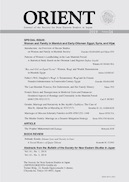Volume 54
Displaying 1-11 of 11 articles from this issue
- |<
- <
- 1
- >
- >|
Special Issue: Women and Family in Mamluk and Early-Ottoman Egypt, Syria, and Hijaz
-
2019Volume 54 Pages 1-6
Published: March 31, 2019
Released on J-STAGE: May 15, 2021
Download PDF (78K) -
Article type: research-article
2019Volume 54 Pages 7-22
Published: March 31, 2019
Released on J-STAGE: May 15, 2021
Download PDF (330K) -
Article type: research-article
2019Volume 54 Pages 23-39
Published: March 31, 2019
Released on J-STAGE: May 15, 2021
Download PDF (165K) -
Article type: research-article
2019Volume 54 Pages 41-53
Published: March 31, 2019
Released on J-STAGE: May 15, 2021
Download PDF (114K) -
Article type: research-article
2019Volume 54 Pages 55-73
Published: March 31, 2019
Released on J-STAGE: May 15, 2021
Download PDF (140K) -
2019Volume 54 Pages 75-84
Published: March 31, 2019
Released on J-STAGE: May 15, 2021
Download PDF (89K) -
Article type: research-article
2019Volume 54 Pages 85-104
Published: March 31, 2019
Released on J-STAGE: May 15, 2021
Download PDF (180K) -
Article type: research-article
2019Volume 54 Pages 105-125
Published: March 31, 2019
Released on J-STAGE: May 15, 2021
Download PDF (136K) -
2019Volume 54 Pages 127-144
Published: March 31, 2019
Released on J-STAGE: May 15, 2021
Download PDF (150K)
Article
-
Article type: research-article
2019Volume 54 Pages 145-172
Published: March 31, 2019
Released on J-STAGE: May 15, 2021
Download PDF (204K)
Book Review
-
Article type: book-review
2019Volume 54 Pages 173-174
Published: March 31, 2019
Released on J-STAGE: May 15, 2021
Download PDF (57K)
- |<
- <
- 1
- >
- >|
